A Conversation with Bruce Duffie


Eleanor Steber
Born: July 17, 1914 (not 1916) - Wheeling, West Virginia, USA Died: October 3, 1990 - Langhorne, Pennsylvania, USA The eminent American soprano, Eleanor Steber, grew up in a musical family. Her mother was an accomplished amateur singer and taught her voice and piano, took her to concerts, arranged for coaching, and strongly encouraged her to study and to sing in school and community shows. Eleanor later studied at the New England Conservatory in Boston, originally intending to major in piano, but her voice teacher, William Whitney, persuaded her to focus on singing, instead. She received Bachelor of Music in 1938. At the beginning she did a lot of radio, oratorio, and church work. Steber’s opera debut was in 1936, appearing as Senta with the Commonwealth Opera in a WPA production of Wagner's The Flying Dutchman, a demanding role indeed for a 21-year-old. In 1939, she went to New York to study with Paul Althouse who had a great influence on her. In 1940 she won first prize at the Metropolitan Opera Auditions of the Air, earning a Met contract. Steber's first role at the Met was Sophie in Strauss’ Der Rosenkavalier on December 6, 1940. During the next years she benefited from conductors such as Bruno Walter, Sir Thomas Beecham, Erich Leinsdorf and George Szell. She was a versatile artist and appeared in Italian, French and German operas. Things began to change for her at the Met when Rudolf Bing took over the company in 1950. By this time, her career extended well beyond New York (San Francisco, Chicago and Europe). At the Met, though, she began to feel that she was being passed over for mainstream Italian roles in favour of Tebaldi and Callas. Altogether she appeared 286 times in New York and 118 times on tour. She sang 28 leading roles in an extremely large repertoire. Her easy upper range, coupled with a rich, smoothly produced lower voice made her a natural for Mozart roles, such as the Countess in Le nozze di Figaro, Pamina in Die Zauberflöte, Donna Anna in Don Giovanni, and even Konstanze in the Abduction from the Seraglio. The 1951 production of Così fan tutte, with Steidry conducting and Alfred Lunt directing, was a major event in the New York season and was recorded on Columbia LP records. As her voice matured, Eleanor Steber sang some of the spinto roles in both the German and Italian repertoire. Her roles in this repertoire included Violetta, Elisabetta, Desdemona, Marguerite, Manon Lescaut, Mimì, Tosca, and the Marschallin in Der Rosenkavalier. In Wagner’s operas she sang Eva in Die Meistersinger von Nürnberg and Elsa in Lohengrin. She was also the company’s first Arabella in 1955, and in 1959 was the first to perform at the Met the challenging part of Marie in Alban Berg’s opera Wozzeck. In January 1958 she created the title role in Samuel Barber’s opera Vanessa, and commissioned his Knoxville: Summer of 1915. 
Her European engagements included appearances at Edinburgh (1947), Vienna (1953), and Glyndebourne. In 1953 she was amongst the first Americans to appear at the Bayreuth Festival after World War II. The very successful 1953 Elsa in the Bayreuth Lohengrin was recorded and issued by London/Decca; it is still in print on Sony CD. In addition to opera and recitals, Eleanor Steber was a frequent guest on The Voice of Firestone's television broadcasts. After several years of absence from the Metropolitan Opera, she took part in the final gala performance of the old opera building in April 1966. After partial retirement in 1962, she turned her attention more and more towards recitals and concerts. She made some appearances on Broadway, mostly in supporting parts, and also gave one of the notorious bathhouse concerts in New York in 1973. She and her husband opened and managed a record label, ST/AND (combining their names).. Steber was head of the voice department at the Cleveland Institute of Music from 1963 to 1972. She taught at the Juilliard School in New York, and at the New England Conservatory of Music (both from 1971), also at the American Institute of Music Studies in Graz (1978-1980; 1988). She established the Eleanor Steber Music Foundation in 1975 to assist young professional singers. With R. Beatie, she published the study ‘Mozart Operatic Arias’ (New York, 1988). Her autobiography, written in collaboration with M. Sloat was published posthumously (New Jersey 1992). -- Throughout this page, names
which are links refer to my Interviews elsewhere on this website. BD
|
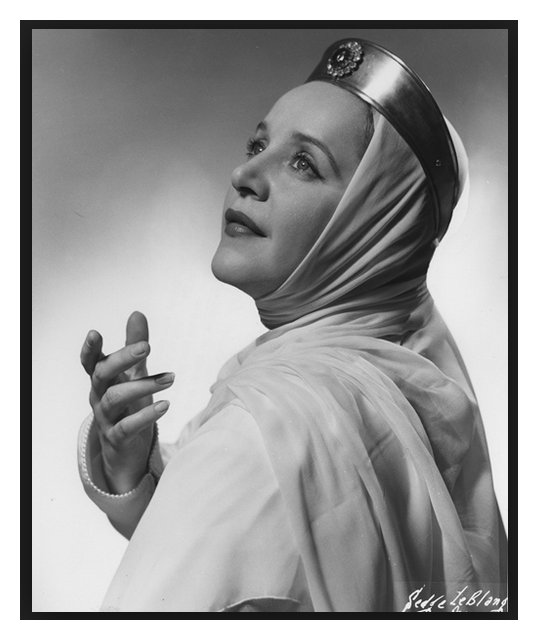 Eleanor Steber:
There’s no real problem about that. Once you learn how to sing Mozart,
all of these things sort of fall into the proper kind of life. Wagner
is just an extension of the beautiful line that you get when you’re doing
Mozart. The style is romantic and requires a great deal of expansion
of tone and expression. But in a sense there is no real problem about
that. I didn’t go very far with Wagner. I didn’t become only
a Wagnerian. Experience is always a very funny thing; I made my debut
as Senta in The Flying Dutchman when I was 21 years old.
But that was when I was in school. I did Eva in Die Meistersinger,
and Lohengrin at the Metropolitan and in Bayreuth and other places.
And there were the smaller roles like Flosshilde, one of the Rhinemaidens,
and the Forest Bird in Siegfried, but they were the smaller roles
at the very beginning of my career at the Metropolitan.
Eleanor Steber:
There’s no real problem about that. Once you learn how to sing Mozart,
all of these things sort of fall into the proper kind of life. Wagner
is just an extension of the beautiful line that you get when you’re doing
Mozart. The style is romantic and requires a great deal of expansion
of tone and expression. But in a sense there is no real problem about
that. I didn’t go very far with Wagner. I didn’t become only
a Wagnerian. Experience is always a very funny thing; I made my debut
as Senta in The Flying Dutchman when I was 21 years old.
But that was when I was in school. I did Eva in Die Meistersinger,
and Lohengrin at the Metropolitan and in Bayreuth and other places.
And there were the smaller roles like Flosshilde, one of the Rhinemaidens,
and the Forest Bird in Siegfried, but they were the smaller roles
at the very beginning of my career at the Metropolitan.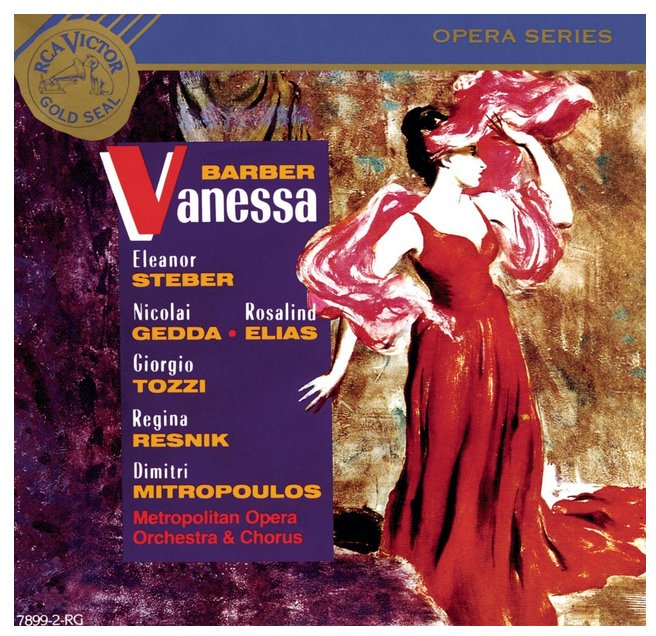 ES:
I don’t think the younger singers ever have a chance to know where in the
hell they are today! [Both laugh] They start out and they make
a success in one part that would seem to have a rather large expanse, like
a Wagnerian role, and all of sudden they’re being thrown into roles that
are like that. They should have a variety which makes it possible for
the voice to expand itself in all ways. Not only that, they have a tendency
to start and do these things much too young. It was a fluke that I
did Senta in The Flying Dutchman when I was 21. It was just
very absurd, but I was very well cared for by my maestro who listened to
me every day. I was not allowed to force anything, and he helped me
to place the whole thing. But youngsters today are thrown in, and all
of a sudden they come on and seem to have done a good Traviata.
I can remember a critic who said one youngster sang Traviata like
a young Steber. So because they said that, all of a sudden they
throw her into Vanessa, and she’s no more capable of doing Vanessa
that flying to the moon! [Both laugh] As a matter of fact, she
came a cropper with it. She really nearly ruined her voice.
ES:
I don’t think the younger singers ever have a chance to know where in the
hell they are today! [Both laugh] They start out and they make
a success in one part that would seem to have a rather large expanse, like
a Wagnerian role, and all of sudden they’re being thrown into roles that
are like that. They should have a variety which makes it possible for
the voice to expand itself in all ways. Not only that, they have a tendency
to start and do these things much too young. It was a fluke that I
did Senta in The Flying Dutchman when I was 21. It was just
very absurd, but I was very well cared for by my maestro who listened to
me every day. I was not allowed to force anything, and he helped me
to place the whole thing. But youngsters today are thrown in, and all
of a sudden they come on and seem to have done a good Traviata.
I can remember a critic who said one youngster sang Traviata like
a young Steber. So because they said that, all of a sudden they
throw her into Vanessa, and she’s no more capable of doing Vanessa
that flying to the moon! [Both laugh] As a matter of fact, she
came a cropper with it. She really nearly ruined her voice.
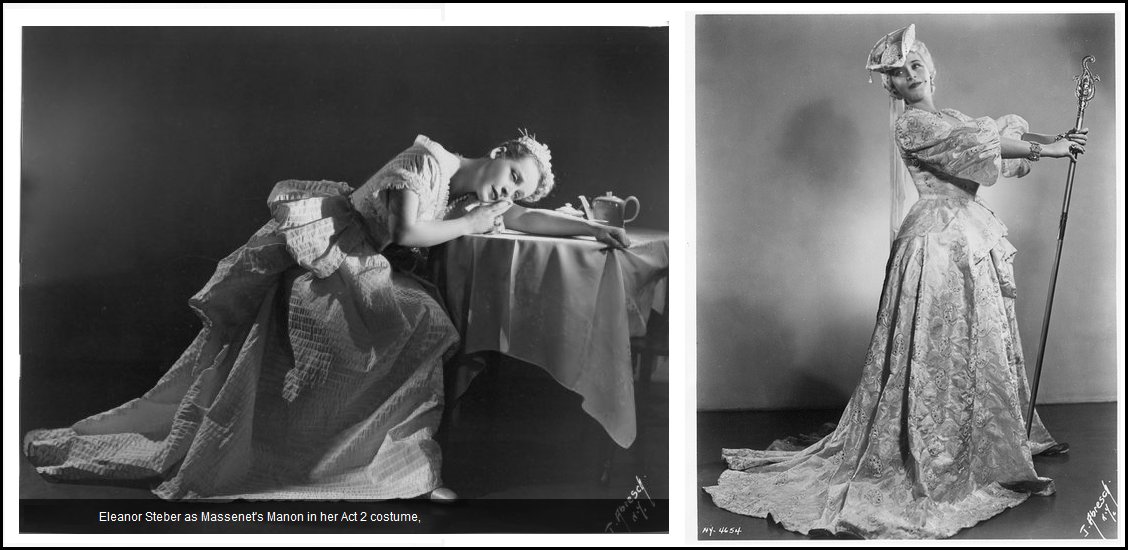
 ES:
No, it was Wolfgang’s first production.
ES:
No, it was Wolfgang’s first production.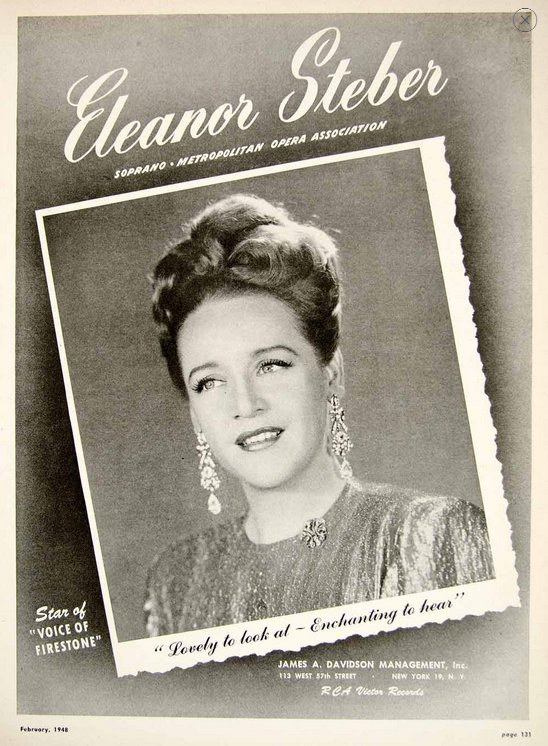 ES: Oh, no! Eva was a very, very serious,
lovely German girl! She was no pixie! There was nothing like
that about her. There was no fun. She was very serious.
ES: Oh, no! Eva was a very, very serious,
lovely German girl! She was no pixie! There was nothing like
that about her. There was no fun. She was very serious.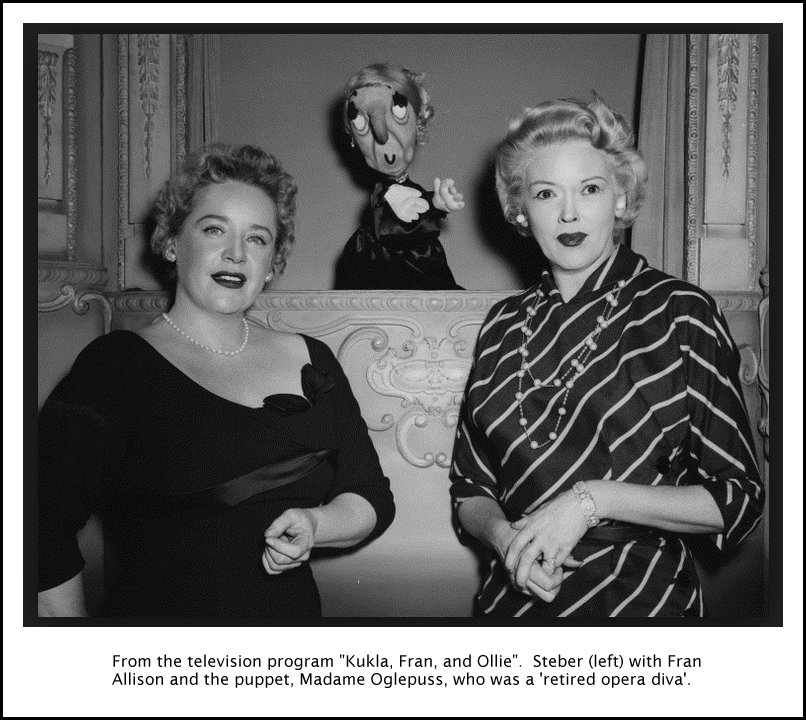
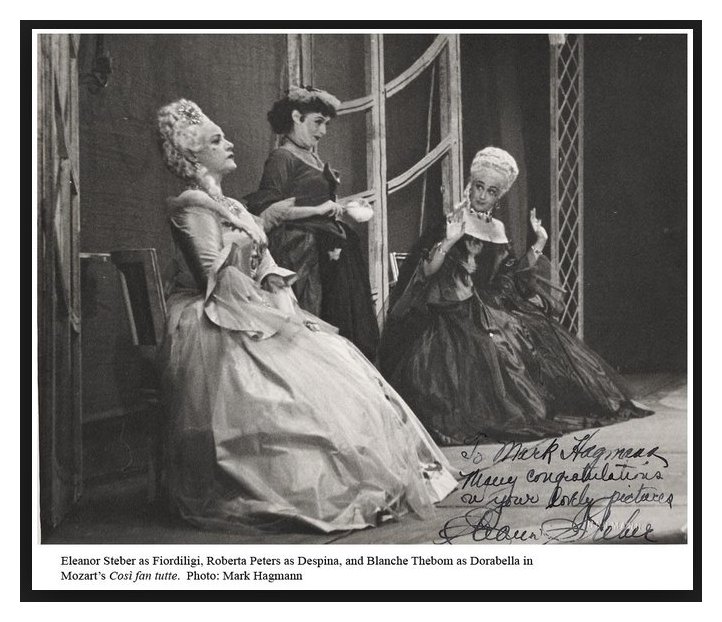 BD: So live opera has to have more immediacy?
BD: So live opera has to have more immediacy?Eleanor Steber
at Lyric Opera of Chicago
1954 - [February] - Don Giovanni (Donna
Anna) with Rossi-Lemeni,
Jordan, Sayão,
Simoneau,
Brownlee, Alvary; Rescigno
[Fall] - Tosca (Tosca) with Di Stefano, Gobbi, Stewart, Badioli, William Mason (Shepard Boy); Rescigno 1956 - [Opening Night] Fanciulla del West (Minnie) with Del Monaco, Gobbi, Wildermann; Mitropoulos Andrea Chénier (Maddalena) with Del Monaco, Gobbi; Buckley Traviata (Violetta) with Simoneau, Bastianini, Foldi, Ardis Krainik (Annina); Bartoletti Don Giovanni (Donna Anna) with Rossi-Lemeni, Likova/Lind, Wilson, Simoneau, Corena; Solti 1957 - Marriage of Figaro (Countess) with Gobbi, Moffo, Berry, Simionato, Badioli; Solti Tosca (Tosca) with Di Stefano/Bjoerling, Gobbi, Smith, Badioli, William Mason (Shepard Boy); Bartoletti 1958 - Traviata (Violetta) with Simoneau, Bastianini, Foldi, Ardis Krainik (Annina); Serafin |
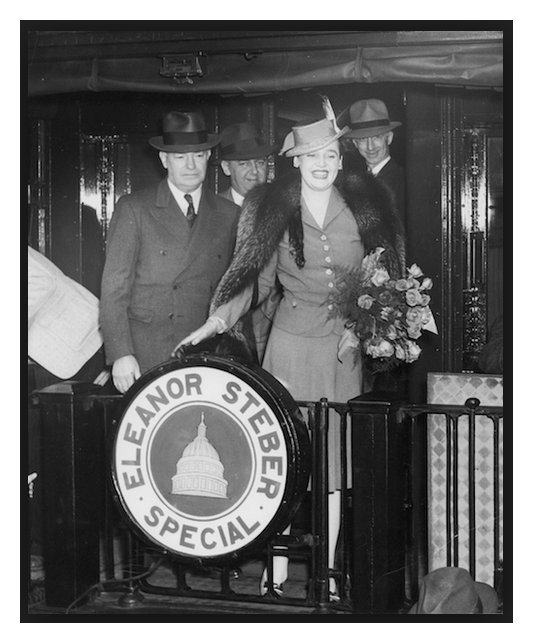 ES:
No, it just happened because I was so unhappy that I wasn’t going to be able
to sing the last show! So I thought maybe I could do it! I talked
about it, and after doing Desdemona, I could do Così fan tutte.
I could do it in my sleep!
ES:
No, it just happened because I was so unhappy that I wasn’t going to be able
to sing the last show! So I thought maybe I could do it! I talked
about it, and after doing Desdemona, I could do Così fan tutte.
I could do it in my sleep!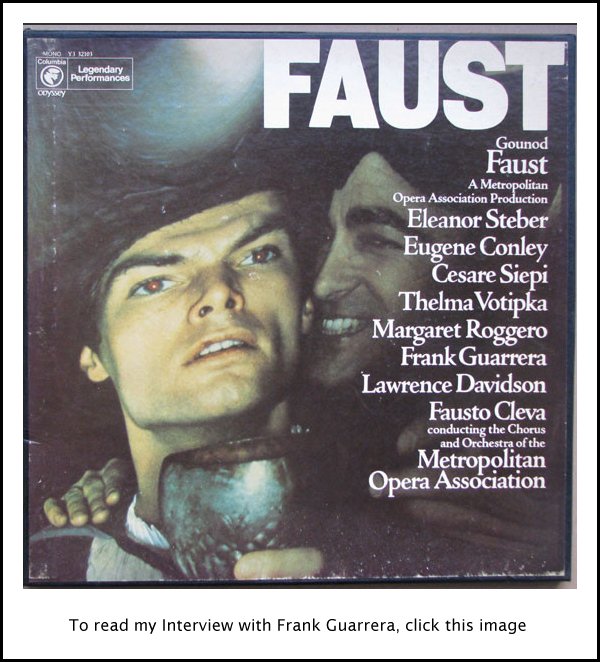




This recording includes songs by Ernst Bacon, Samuel Barber, Jack Beeson, William Bergsma, John Alden Carpenter, Theodore Chanler, Aaron Copland, Henry Cowell, David Diamond, John Edmunds, Irving Fine, William Flanagan, Charles Tomlinson Griffes, John Gruen, Charles Ives, John La Montaine, Otto Luening, Edward MacDowell, Douglas Moore, Vincent Persichetti, Ned Rorem, Virgil Thomson, and Robert Ward. The pianists are Edwin Bilcliffe, and Richard Cumming. Also see my interview with Donald Gramm. 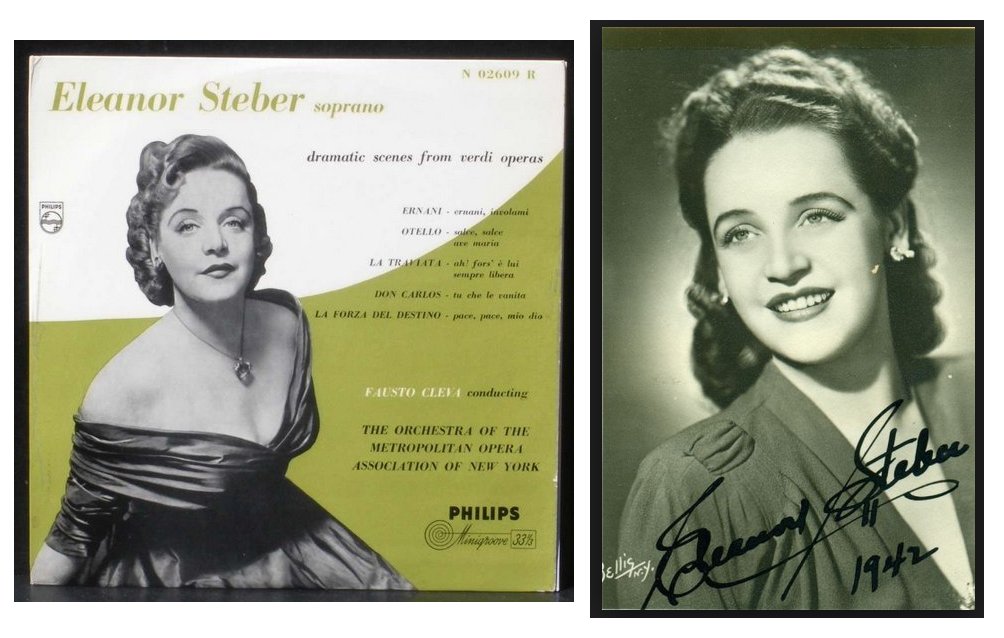
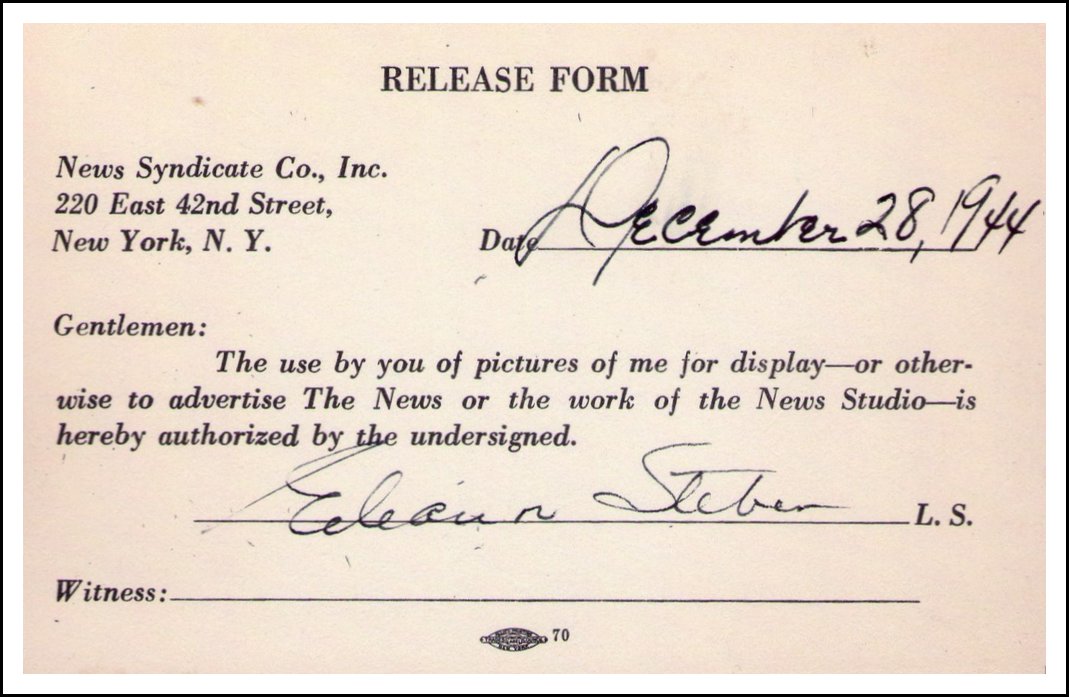
|
© 1985 Bruce Duffie
This conversation was recorded on the telephone on March 16, 1985. Portions were broadcast on WNIB the following year, and again in 1994, 1999, and 2000. This transcription was made in 2016, and posted on this website at that time. My thanks to British soprano Una Barry for her help in preparing this website presentation.
To see a full list (with links) of interviews which have been transcribed and posted on this website, click here. To read my thoughts on editing these interviews for print, as well as a few other interesting observations, click here.
Award - winning broadcaster Bruce Duffie was with WNIB, Classical 97 in Chicago from 1975 until its final moment as a classical station in February of 2001. His interviews have also appeared in various magazines and journals since 1980, and he now continues his broadcast series on WNUR-FM, as well as on Contemporary Classical Internet Radio.
You are invited to visit his website for more information about his work, including selected transcripts of other interviews, plus a full list of his guests. He would also like to call your attention to the photos and information about his grandfather, who was a pioneer in the automotive field more than a century ago. You may also send him E-Mail with comments, questions and suggestions.